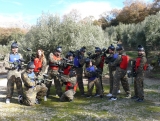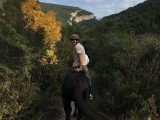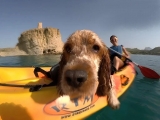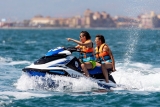In this article, you’ll discover the most fascinating marine spaces along the Mediterranean coast that bathes Murcia. Will you be able to choose the dive spot that leaves you utterly amazed?

Diving Along the Coast
One of the main features of this route is the presence of underwater meadows of Posidonia oceanica. These meadows are vast formations of vegetation, much like on land, that take over the terrain. Posidonia does this underwater, thanks to the clear waters that allow light to penetrate, anchoring itself to the seabed through its roots and colonising the submerged surface.
Sheltered by these plant formations, numerous animal species are born and thrive, finding everything they need to survive in these meadows. Additionally, many species have achieved chromatic mimicry with this environment. A clear sign of these underwater meadows is the traces they leave on Murcian beaches during autumn, starting at La Manga.
You’ll only need to dive to a shallow depth to observe the plant species and their inhabitants. Cuttlefish, octopuses, mullets, damselfish, and pen shells are all part of this underwater world sustained by the submerged meadows.
As you advance on your diving route towards Cabo de Palos, you’ll notice how both the exterior and underwater landscapes undergo significant changes. Here, thanks to the greater depth, strong currents, and nearby shallows, you’ll encounter creatures very different from those in previous areas.
From Las Hormigas to Bajo de Fuera
Starting now from Cabo de Palos, you’ll embark on a new adventure heading northeast, filled with reefs like Testa, Piles, or Dentro, until you spot Las Hormigas Islands. At this point, you’re already 2 miles from the coast. Continuing in the same direction, 1,500 metres ahead, you’ll find the rocky seabed rising to form Bajo de Fuera, with a charted depth of 5 metres. Here, you’ll notice the most radical change: from a bright seabed teeming with underwater meadows to a deep, dimly lit environment (ideal for corals).
This stretch from Las Hormigas to Bajo de Fuera is characterised by a wide variety of animals grouped in colourful clusters, creating spectacular scenes. Additionally, as you go deeper, you’ll find yellow coral formations and sea feathers among the mud and gravel of the seabed.

During this dive, you might even spot typical open-water species (sunfish, eagle rays, or small sharks). As if to make the underwater landscape around Bajo de Fuera even more spectacular, scattered shipwrecks lie beneath the sea.
Precisely because of these features, Bajo de Fuera is now part of a marine reserve, with strict restrictions on diving or fishing. We recommend checking the area’s regulations before planning your dive.
Cabo Tiñoso
Once past the beaches of Portus and La Morera, the coast rises again with the Sierra de la Muela, reaching 600 metres at Peñas Blancas. This gives way to Cabo Tiñoso, where towering cliffs host a wealth of benthic and pelagic organisms.
Between Cabo Tiñoso and Punta de la Azohía, a 3-mile cliff stretches. This is one of the most significant maritime spaces on Murcia’s coast due to the cliff’s depth, underwater topography, and water conditions. Proof of its historical importance are the remains of Roman tuna traps still visible on the seabed.
Near Cala Aguilar, close to Cabo Tiñoso, you’ll find a stunning underwater cave with an inner lake: the Cueva de Neptuno. The cave entrance sits at 14 metres depth, accessed via a 5-metre tunnel.
Puerto de Mazarrón
This small town has recently become a hub for adventurers across Spain. The underwater terrain here is highly engaging for diving. Key dive spots include Punta de los Aviones, Punta Negra, La Isla, and Bajo de Fuera.

Monte de Cope
This mountain forms a peninsula flanked by Ensenada de la Fuente (east) and Calabardina (west), an ancient Roman Urci. Its rocky cliffs span 2 miles, shielding the area from easterly winds.
In Calabardina, you can explore the Cueva de la Virgen, one of the most visited dive spots on the coast. This cave is a 12-metre-deep gallery teeming with fish fed by divers. The natural seascape is enhanced by sunken ships acting as artificial reefs.
This stretch was vital for Greeks, Phoenicians, Romans, and Carthaginians, who established ports and mines here, leaving valuable archaeological treasures.
Around Cope and Fraile cliffs, you’ll see stratified rock blocks from collapses, inhabited by countless organisms and species. For larger species, venture further offshore to less accessible areas.

Now you know what awaits when diving along the Murcian coast—just pick your favourite stretch and explore it yourself. And if you love adventure, why not tackle it all?











